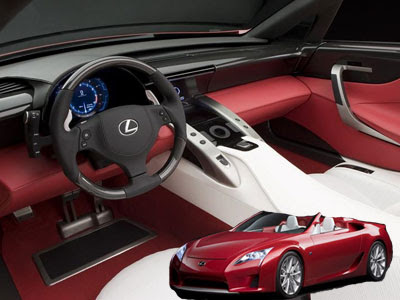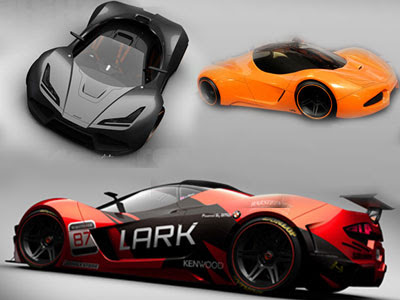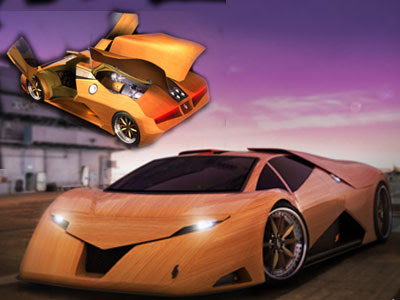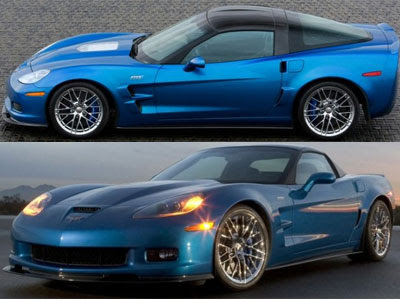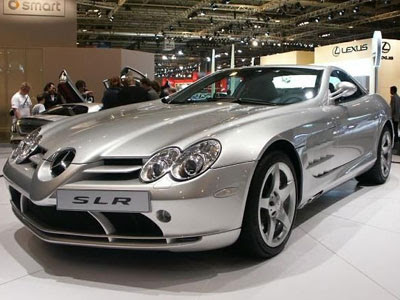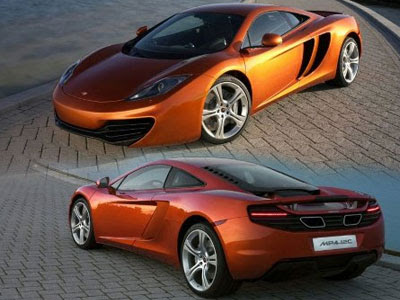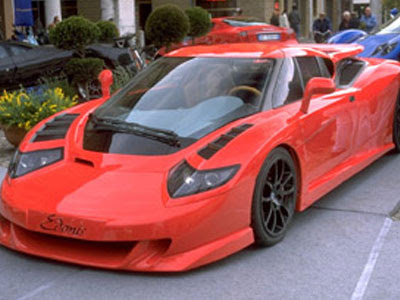Sunday, July 3, 2011








Labels: 2011, McLaren, McLaren Sport Cars, Race Car, Racing, Racing Car, Sport Cars, Super Car, Super Sports Cars, V8
Thursday, June 16, 2011








Labels: 2011, Jaguar, Jaguar Cars, Jaguar Sports Cars, Sport Cars, Super Car, Supercars
Thursday, May 20, 2010
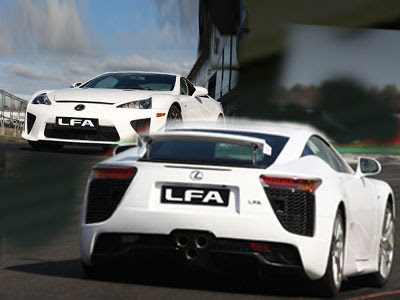
Power for the rear-wheel-drive Lexus LFA, which is constructed using advanced carbon fiber technology, comes from a mid-front mounted 4.8L V10 engine that red lines at 9,000 rpm and makes 552-hp with a maximum torque of 354 lb-ft. Mated to a 6-speed Automated Sequential Gearbox, the LFA goes from 0-62 mph in just 3.7 seconds (0-60 mph in 3.5 seconds) with a top speed of 202 mph.

The Lexus LFA coupe will be produced at the Motomachi plant in Toyota City. Toyota will make just 500 examples at rate of 20 units per month “to ensure the finest build quality and attention to detail.”
The UK launch price for the LFA is €368,000 (approximately £336,000)
Labels: Coupe, Lexus, Sport Car, Super Car, Super Sport Car
Wednesday, April 7, 2010




Labels: 2012, Lamborghini, Sports Car, Super Car
Thursday, November 5, 2009

The Lexus LFA coupe will be produced at the Motomachi plant in Toyota City. Toyota will make just 500 examples at rate of 20 units per month “to ensure the finest build quality and attention to detail.”
The UK launch price for the LFA is €368,000 (approximately £336,000).
Labels: Coupe, Lexus, Sport Car, Super Car, Super Sport Car
Wednesday, November 4, 2009
The LF-A Roadster’s LEXUS V10 engine supercar Concept.
Lexus will stage the Australian debut of its own supercar, the LF-A Roadster, at the Melbourne International Motor Show on 27 February.The LF-A Roadster goes on display in Melbourne after headlining motor shows in Tokyo and Detroit.
Its sleek design utilises a lightweight carbon-fibre and aluminium body that ensures structural rigidity is maintained, even without a roof.
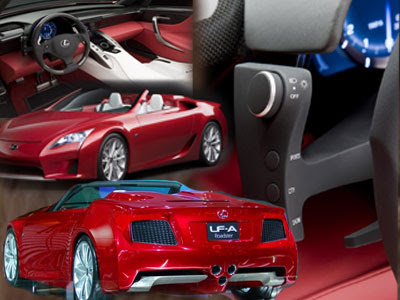
Styling of the LF-A Roadster draws extensively from the Lexus L-Finesse design philosophy and has been designed to deliver maximum aerodynamic efficiency.
The rear of the Roadster is marked by a pair of wrap-around, arrowhead-shaped taillights and a trio of centrally positioned exhausts.
To attain the best possible weight distribution, Lexus engineers positioned the radiators at the rear of the vehicle, which also allows for a sleeker front-end design.
The two rear-mounted radiators are fed cool air by two large intake ducts located forward of the rear wheel wells, and heated air is vented out behind the vehicle via a pair of large grilles.
The engine is mounted in a “front-mid” configuration – in front of the passenger compartment, but behind the front-axle centreline.

The engine is connected via a torque tube and propeller shaft to a transaxle that is controlled by paddle shifters. The torque tube is a structural member that adds rigidity to the drive train and chassis, while also reducing vibration.
The LF-A Roadster features wide high-performance tyres on turbine-styled alloy wheels.
The Melbourne International Motor Show is on at the Melbourne Convention and Exhibition Centre from 27 February to 9 March.
Labels: Concept Car, Lexus, Spors Car, Super Car
Wednesday, October 14, 2009
The LM5 was designed as a vehicle which could rekindle the drama and sophistication of the legendary McLaren F1. And while McLaren have since revealed the MP4-12C supercar, it's not exactly in the same league as the technological tour-de-force which was the original F1.
The McLaren LM5 is a concept created by Matt Williams, a graduate of Coventry University's Transportation Design degree program. The LM5 was produced as his final year project.
The styling of the F1 was primarily dictated by function. However it also retained a unique sense of character and presence. Williams thought it would be interesting to develop the brand identity of McLaren - but more specifically the F1 model - and bring it into the 21st Century. And while the LM5 concept was designed to offer a similar personality and overall stance to the F1, it was also designed to utilize more extreme and race-influenced bodywork.

The McLaren LM5 concept features the same three-seat layout with a central drivers seat as the old F1. All three sports seats have an extremely slim profile to reduce weight and free up interior space, and instead of conventional safety belts all the seats feature racing-style four-point harnesses. The multifunction steering wheel features a central display for the tachometer.
The proposed engine for the McLaren LM5 concept is a worked over 5.0 litre V10 sourced from BMW. Mounted midship in the carbon fibre pre-preg chassis this unit would make the LM5 a force to be reckoned with on both road and track.
While the LM5 is at the moment just one man's idea of what the F1's successor could look like, the design itself uses both past and present McLaren influences giving it a sense of realism. And It's important to remember that McLaren themselves have made it public knowledge that they're working on developing a successor to their most iconic car within the next couple of years.
Labels: Concept Car, Design Car, McLaren, Race Car, Spors Car, Super Car
Splinter Wooden Supercar the first supercar ever to be designed and engineered using wood
0 comments Posted by org at 7:50 AMThe Splinter is a very unusual and innovative vehicle. It's the first supercar ever to be designed and engineered using wood as the primary construction material. In the past some vehicles have used wood to various degrees in their construction, but never to the extent the Splinter does.
The Splinter is a graduate project by students at North Carolina State University. Wood has been used where possible, including the chassis, body, and even a large percentage of the suspension components and wheels.
While moving components like the suspension might seem impossible to fashion out of wood, the Splinter team realized that a leaf spring shares many traits with longbows, flexible, durable and with progressive spring rates. After research they decided to use Osage orange wood, which is the strongest wood found in North America. The front suspension therefore comprises of a laminated Osage orange wood leaf spring transversely mounted and providing suspension for both front wheels.

The wheels of the Splinter are made from rotary cut oak veneers. Each veneer was rotated 36 degrees from the previous layer to maximize grain direction alignment with the spokes. A walnut sunburst was cut for the front while a cherry sunburst was used on the back.
The mid-engined layout of the Splinter wooden supercar comprises of a 4.6 litre, twin supercharged V8 mated to a 6 speed manual gearbox and Getrag limited slip differential.
The Splinter is not intended for mass production, nor is it designed to break and performance or handling records. The design is merely to show that with intelligent and creative thinking a car can be created out of the most unlikely materials.
Labels: Design Car, Splinter, Spors Car, Super Car
Tuesday, October 13, 2009
The engine purrs like a kitten and roars like a lion at top speed. The interior of the car is everything you would expect from a sports car. This will be the next car on the top of every collector's list. Once rumored to be the "Blue Devil", the ZR1 Corvette offers comfort and charm all wrapped into one package. It will not be easy to produce a follow up Corvette that can match it's speed and style.
The carbon roof adds a touch of class to the 2009 Corvette ZR1 and only increases it's world class sports car appearance. The body style is designed for speed with the supercharged engine, there is not problem reaching top speeds on a good dry road. Chevy has created a new breed of luxury sports car that will surpass all others in its' class and price range.
The easy to reach dashboard controls has improved in the 2009 Corvette ZR1. The driver will easily be able to control the heat and cooling as well as all other controls without much effort when traveling at high speeds. The interior is a simplistic and refined while the exterior is bold and distinguished. The bucket seats have a stylish two color design that really sets it apart from other Corvettes. Rest assured, the interior is set up with the sophisticated driver in mind and has plenty of room for a comfortable ride.
The 2009 Corvette ZR1 was promised to be the best Corvette Chevy has ever produced and from the looks of the car and the horsepower, they have succeeded in delivering a car that is all that and more. The price of the 2009 Corvette ZR1 will be worth every penny based on the shear style & muscle this car provides. For die-hard Corvette collector, the MSRP is well worth what you will receive in return. For non-diehard Corvette individuals, you also will be nothing short of amazed by what this vehicle has to offer vrs sports cars within its' class. Don't believe me? Take a ride to our dealership and check it out for yourself. You will be happy you did!
The 2009 Corvette ZR1 has ABS, vented disc brakes in the front and the back. The driveline is rear wheel drive with tires that were developed just for the 2009 Corvette ZR1. They are Michelin Pilot Sport 2, P285/30ZR19 for the front and P335/25ZR20 for the rear. The front bakes have 6-piston calipers and the back has 4-piston calipers. The rotor diameter is 15.5 for the front and 15 for the back.

2009 Corvette ZR1 Engine The engine is a LS9 Supercharged V8 with a displacement of 376 cubic inches with 620 's for horsepower. The car has 595 pounds of torque. The clock and cylinder head are made from cast aluminum. The bore and stroke is 4.06 x 3.62 inches. The valve train has two valves per cylinder with an overhead valve. The fuel is delivered by sequential fuel injection and the engine has a compression ratio of 9.1 to 1. The recommended fuel is premium.
The transmission is a six speed manual transmission with a dual disc clutch. Gears ratios are 2.29 to 1 for first, 1.61 to 1 for second, 1.21 to 1 for third gear and 1.00 for fourth, 0.81 to 1 for fifth and 0.67 to 1 for sixth gear. Reverse is 3.11 to 1. The final drive ratio is 3.42 to 1. The clutch offers great clamping power with easy effort. The top speed can be achieved in sixth gear in this car. The twin disc clutch uses two discs to spread the torque of the engine load over a wider area. This also helps to dissipate the heat more and helps with extending the life of the clutch, which is needed in this sporty little car.
The length of the car is 176.2 inches with a height of 49 inches and 75.9 inches wide. The wheelbase is 105.7 inches. The fuel rank is 18 gallons and the engine holds 12.5 quarts of oil. The speedometer will read out up to 220 miles per hour, which is very easy to do with the supercharged engine and twin disc clutch.
The 2009 Corvette ZR1 comes with Bluetooth connectivity, navigation system, leather wrapped interior and leather trimmed sport seats that are power adjusted. The car does offer four different colors for the interior. The car will come with its own unique VIN number that will tell how many were built for the specific year and model. Come test drive one today!
Labels: Corvette ZR1, Sports Car, Super Car
Friday, October 9, 2009
This sports car combines the old yet astounding SLR race cars of the 50s and the latest and meanest technology of high-performance supercars. With the power of race cars and the sleek, curves and designs of a luxury car, the combination from the two car manufacturers is hard to beat.A blast from the past and a taste of the future, this might just be a good description of the latest sports car that came out from a collaboration of Mercedes-Benz and McLaren, two big giants in the car manufacturing industry. We're talking about the 2004 Mercedes-Benz SLR McLaren.
This supercar is definitely fast. SLR McLaren sports a 626-horsepower supercharged 5.5-liter V8. Also, it has a full carbon-fiber monocoque, features crash structures and body panels. And with the supercharge V8 engine, you can see the 2004 Mercedes-Benz SLR McLaren go from naught to 60 miles per hour in less than 3.6 seconds. Top speed has been measured to exceed 200 mph, a feat that can only be achieved by very few even among the high performance sports cars. It was the high-performance division of Mercedes-Benz which created the V8s. The AMG were the ones who hand-build the supercharged V8 engines with top notched precision and quality. It is not at a big surprise to see the supercharged 5.5 (5439 cc) liter dry sumped 90 degree V8 engine to produce around 466.8 kW at 6500 rpm (626 hp) and 780 N·m (575 ft·lbf) torque at 3250 - 5000 rpm. The numbers maybe daunting but the sound of the engine will appease the minds of those who long for the perfect high performance cars.
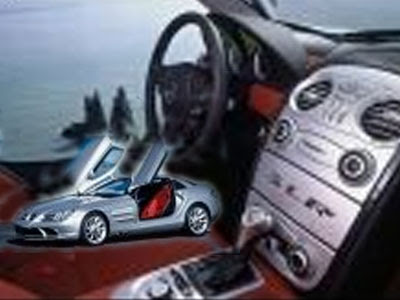
Mounting that V8 engine into the body of SLR exotic car is also not as traditional as one would like to expect. The engine in SLR sports car is placed in a front mid-engine position just behind the front wheels. Instead of using the traditional oil-pan, dry-sump lubricants are used. With this innovation, it is highly possible to mount the engine to a level that used to be unachievable. Because of the low position of the engine in the supercar's body, the results are more than one hoped. The new Mercedez-Benz SLR McLaren race car has better aerodynamics and better handling due to the lower center of gravity.
Not only does the mean features of the sports car that attracts attention but how the two car companies were able to fuse their own traditions and expertise into a single exotic car. For one, McLaren's expertise in Formula 1 has been imbibed wholly by the SLR's design. The composition of carbon fiber material that was used in the body of the new SLR sports car is so Formula 1. Because of this body, the Mercedes-Benz SLR McLaren has become more rigid and surprisingly strong.
The SLR also has a five speed automatic transmission. There are modes, the Sport, Comfort and Manual which basically covers every known driving style. Sport is for everyday use, Comfort for bumpy or slippery roads, and Manual gives you control over the gears either through the touchpad or the levers on the steering wheel. When you use Manual, you open up three more modes, namely Sport, Supersport and Race. Speed increased significantly as you go up shifts.
With all these features it is not surprising that the Mercedes-Benz SLR McLaren is classified as a sports car and a supercar. Remember to get this right, though, the "SLR" does not stand for "Sportlich, Leicht, Rennsport" which is German for "Sport; Light; Racing" as most people think. Its real meaning is "super-leicht, Rennsport" which means "super-light, racing." The sports car is being sold with a base price of €443,066 £300,000 or $450,000.
Labels: McLaren, Mercedes-Benz, Race Car, Sports Car, Super Car, Supersport Car
Saturday, October 3, 2009
Shelby Supercar engine in the base Aero model is same as the previous year, but the Ultimate Aero has a 6.35-litre (387.2 cu in) engine, rated at 1,183 bhp (882 kW) at 6950 rpm and 1,094 lb·ft (1,483 N·m) torque at 6150 rpm, and the supercharger is replaced by a twin turbocharger with cabin adjustable boost pressure. The car is designed to use 91-octane gasoline. The 6-speed transmission is readjusted to increase the theoretical top speed to 273.75 mph (437 km/h) at 7200 rpm, however whether the vehicle is able to reach this speed is highly questionable and has never been tested.
Twin-Turbo V8 Engine with 1183 hp, base price is $654,400. Tested in March 2007 by Guinness world records
Wheels on the base model are sized 18-inch at the front and 19-inch at the rear, while the Ultimate Aero TT has wheels an inch larger at each end.
The 2007 models are heavier, with the base model weighing 2,850 lb (1,290 kg), and Ultimate version 2,750 lb (1,250 kg). Unlike the previous year, base models have a navigation system, 10-speaker audio/CD/DVD system, video/DVD screen, back-up camera, air-conditioning, and trunk space as standard equipment. These come optional on the Ultimate.
Labels: Design Car, Shelby, Sport Car, Super Car
Friday, October 2, 2009
Double mid McLaren MP4-12C was completed “in one piece” carbon chassis, which carries the aluminum and special plastic body panels. Eight-installed 3.8-liter engine with an angle of 90 degrees to the collapse of the cylinders and the two turbines. Its capacity is about 600 horsepower and maximum torque is 595 Nm (80 per cent of which is already available from 2000 rpm).
The motor will be used with the seven-Graziano robotized transmission with dual-clutch transmission and a choice taxied. According to preliminary data from the ground up to “hundreds” McLaren supercar will drive for about three seconds. Its top speed of 320 kilometers per hour.
Sales of McLaren MP4-12C, which is scheduled to release a limited edition of one thousand copies, will be no earlier than 2011. The car will do to the markets of USA, UK, Germany, Europe and the Middle East.
Labels: 2011, Concept Car, McLaren, Sport Car, Super Car
Monday, January 12, 2009
The Edonis cannot be described as a beautiful car, but it certainly eye catching. Its angular, complicated lines crash awkwardly together in a chaotic fashion, this trend is evident from almost every angle. The headlights give the impression of tiredness, or even depression.
The Edonis supercar is a creation of B. Engineering, a company run by Jean Marc Borel. The Edonis was intended as a demonstration of the design and prototype abilities of his company. The B. Engineering Edonis is a genuine supercar with a 0-60 time under 4 seconds, and a maximum speed of 225 mph.
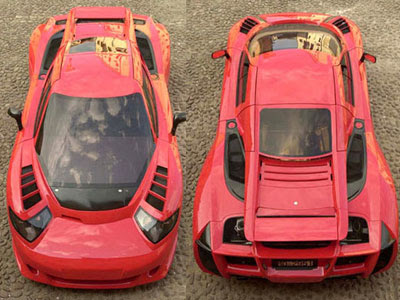
The Edonis has little to be sad about. Twin turbochargers feed a 3.7 litre V-12 engine to create a whopping 680 bhp at 8,000 rpm. All this power is run through a six-speed manual gearbox.
Using a monocoque built from carbon fiber the Edonis is very strong and light. All the cosmetic exterior body panels are aluminum. To reduce weight further aluminum brake calipers are used.
To save even more space and weight the Edonis rides on Michelin PAX run-flat tires, this means a spare wheel is surplus to requirement.
Labels: Design Car, Edonis, Prototype, Super Car
Monday, January 5, 2009
The TC 522 was powered by a mid-mounted 5.7 litre, twin-turbo V8. The transmission was handled by a 6 speed manual driving the rear wheels. The Spiess TC 522 had a carbon-fibre composite body. Due to its high price, and a worldwide economic slow down, the TC 522 never left the prototype stage.



